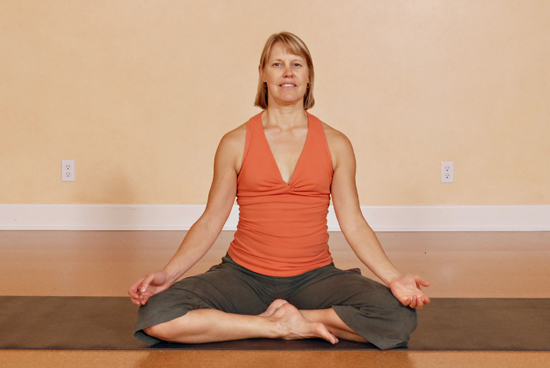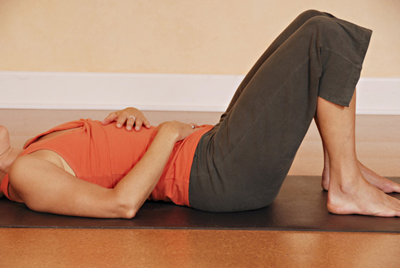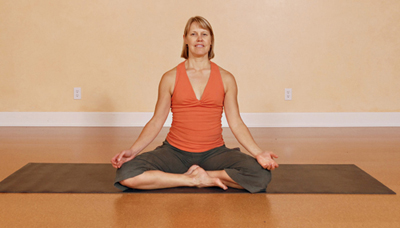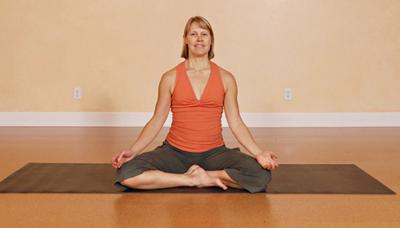Although in the West we may tend to think of yoga as primarily physical postures, yoga as a discipline is much broader than this. Traditional yoga texts talk about the “eight limbs of yoga,” with each limb representing a type of practice within the framework of yoga. Physical poses, or asanas, are just one of these eight limbs of yoga. In fact, asanas were traditionally practiced in order to calm the body, increase flexibility and open the energy channels so that the practitioner could sit comfortably for an extended time in meditation.
While it is not within the scope of this book to discuss all of the eight limbs, we would like to offer some practices from a few of these “limbs.” The practices described below are specifically tailored to help reduce stress and enhance fertility. These can be done at the beginning or end of the yoga routines we have offered in earlier chapters, or they can be done as stand-alone practices. You may want to do some of the physical yoga poses first, in order to calm and open the body. This will make sitting still to breathe or meditate easier. You can also do any of the meditations offered below while resting in one of the relaxation poses we have described, such as Legs-up-the-Wall Pose, or supported Cobbler Pose.
The Eight Limbs of Yoga
Yamas: ethical guidelines on how to act in the world
Niyamas: ethical guidelines on personal behavior and discipline
Asanas: practice of physical poses
Pranayama: conscious breathing practices
Pratyahara: control of the senses, freeing oneself from distraction
Dharana: meditation, concentration and cultivating self-awareness
Dhyana: devotion; meditation on the Divine
Samadhi: merging of the Self with the Divine
Pranayama is simply the practice of breathing consciously. Of course, we breathe all day long without paying the slightest attention to our breath, and without instructing our body to breathe—otherwise we would be able to do nothing else all day long! So, it is possible to have the breath running on “automatic pilot,” which we do most of the time. But it is also possible to take conscious control of the breath, and change the way we breathe, which is what we do when we practice pranayama.
Interestingly, breathing is the only bodily function where we can choose to either control it, or put it on auto-pilot. If you want to pick something up, for instance, you will need to consciously think of this, and your brain will need to instruct your hand to do the picking- up action. Other systems, such as the heart, are on auto-pilot, and we don’t choose to make it beat or not (although some famous studies conducted at the Menninger Clinic in the 1970s demonstrated that the accomplished yogi Swami Rama was able to make his heart rate beat 360 beats per minute and then reduce it almost instantly to 52 beats per minute).1
Prana, the basis of pranayama, means more than just “breath” in the Western sense of that word. Prana is actually the life-force energy that energizes all aspects of life in the universe. So, when we are breathing, we are bringing in not just oxygen and carbon dioxide, but also life- force energy. With conscious breathing practices, we can bring in more of this life-force energy.
In normal daily breathing, most people use only about 15% of their total breathing capacity, which means that most people are breathing into and out of the upper chest. One of the most basic breathing practices that we do in yoga for fertility is to learn to take the breath all the way into the low belly, thus increasing the quantity of prana we are able to take in on each breath. Also, we can focus the prana into a particular part of the body, if we choose, in order to bring additional life-force energy there. In this case, we are focusing the life-force energy into the low belly area, which contains our center of reproduction.
Yoga breathing is generally done using the nose for both the inhale and exhale. The spine should both lengthen on the inhale and maintain its length during the exhale, without moving the shoulders up and down. Note: A few specialized breathing practices use the mouth for exhaling, but those practices are not generally recommended for fertility support. Retaining the breath after inhale is also not recommended for women trying to conceive.
We have offered suggested numbers of rounds for some of the practices. One round is one inhale and one exhale. However, it would be best to do each practice until you have a feeling of calm, even if it takes more than the number of rounds we have suggested.

For seated breathing practices, you may want to sit up on the edge of a cushion or blanket to allow hips and knees to open more easily. Seated breathing practice is usually done seated in a comfortable, cross-legged position, in order to keep the lower body grounded and to provide a still and firm base. Start by finding the sitting bones, so that you are sitting straight down through them, not slouching back or leaning forward. Allow the shoulders to relax. Reach the crown of the head up toward the ceiling. See that your chin is drawn back slightly, and not jutting forward. If the head is pitched forward at all (think of peering at your computer screen, or over the steering wheel of your car), this posture constricts the breath. It is impossible to take long, deep breaths with the chin jutting forward, and yet this is the posture we very commonly see around us, especially in the Western world. Note: If it is not comfortable for you to sit on the floor, it is also possible to do the breathing practices in a straight-backed chair with a firm seat, maintaining a long spine.
Yogic breathing is very calming. All the breathing practices are useful for stress reduction, calming anxiety, reducing insomnia and smoothing out mood swings. From a yoga perspective, this kind of conscious breathing also helps to open the “nadis,” which are energy channels that run to all parts of the body.
Pranayama also stimulates the vagus nerve, which is one of the most important nerves in the body, reaching from the brain stem all the way into the belly. This nerve physiologically provides the “plumbing” behind the mind/body connection. Stimulation of the vagus nerve is used by doctors to calm heart palpitations and anxiety, and treat depression, among other things. This effect on the vagus nerve may help explain why pranayama practices are so calming to the central nervous system.
In addition, breathing practices can help with specific things such as:
 balancing the feminine/masculine energy in the body,
balancing the feminine/masculine energy in the body,
 balancing the functions of the sympathetic (“fight-or-flight”) and parasympathetic (“relaxation response”) nervous systems,
balancing the functions of the sympathetic (“fight-or-flight”) and parasympathetic (“relaxation response”) nervous systems,
 enhancing the communication between the right hemisphere of the brain (intuitive, creative) and the left (analytical, linear).
enhancing the communication between the right hemisphere of the brain (intuitive, creative) and the left (analytical, linear).
Sit in a comfortable seated, cross-legged position. You may want to sit up on one or two folded blankets if your hips, knees or low back are uncomfortable when sitting on the mat without support. Make sure you are sitting straight down on your sitting bones, and the crown of the head is reaching up toward the ceiling. The spine should feel lengthened. Another option is to sit in a chair with a solid seat that will allow you to sit with a long spine. Let your body relax. Begin taking deep, slow inhales and exhales. Try to bring the breath all the way down into the belly on the inhale. Exhale completely. Build in a little pause at the end of the exhale, before you begin inhaling. Do this practice until you begin to feel calm. Note: for all of these breathing practices, we recommend closing the eyes, if possible, to minimize distractions.
Do the seated deep breathing practice above, but this time try to draw the breath up and down the back of the throat, so that you can hear it moving. You can feel what this is like by opening your mouth and pretending to fog a mirror. Notice the slightly raspy sound and feeling in the back of your throat. Try it on an inhale, by making a gasping noise. Now, see if you can make this sound with the mouth closed. This is what we would like to feel and hear on both the inhale and exhale when we do audible breathing. Try 8–12 rounds.
Lie on your back with the legs straight, or bend the knees if it is more comfortable for the low back. Take one hand on your belly, the other hand on the low ribcage. Use the hands to feel where your breath is going. Begin by allowing the abdomen to expand on the inhale, then flatten back on the exhale. Try to make the inhale and exhale about the same length, or make the exhale slightly longer. Continue for 12–20 rounds.

After you get comfortable with the Belly Breath, you can try this variation. After expanding the abdomen on the inhale, draw the inhale upwards and expand the ribs, and finally bring the breath all the way up into the chest. Exhale from the top down, starting with the chest, then empty the ribcage, and finally allow the low belly to flatten back toward the spine. Continue for 8–10 rounds.
Start either sitting comfortably, or lying on the back. Inhale for a slow count of 4, pause slightly, then exhale for a count of 4. Pause after the exhale, before starting the inhale. Repeat. Try 10–12 rounds of this counted breath. Once you are very comfortable with this breath, you can try increasing the count to 6 or 8.
Sitting comfortably, raise your right hand, and allow your left hand to rest comfortably in your lap. You will be using the thumb and 4th finger (ring finger) of your right hand only. The thumb is used to close the right nostril, and the 4th finger is used for the left.


Begin by exhaling all the air out of the lungs through both nostrils. Close your right nostril with your thumb, and inhale through left nostril only. Pause briefly with the air held in, then close the left nostril using your 4th finger. Exhale through the right nostril only. Make sure to exhale completely. Without moving the hand, and keeping the left nostril closed, inhale through the right nostril only. Using the thumb to close the right nostril, exhale out the left nostril only. Try this for 8 rounds (the whole process described above is one round). You could gradually add more rounds as you become comfortable with this breathing practice.
Alternate nostril breathing is very calming, and is also useful for balancing the feminine/masculine or yin/yang energy in the body, as well as balancing the left and right brain functions. Breathing through the left nostril activates the right hemisphere of the brain, (the more intuitive, creative side) and breathing through the right nostril activates the left (the more linear, analytical side). In fact, your body automatically does its own alternate nostril breathing, by switching the dominant nostril approximately every 2 ½–4 hours, on a regular schedule!
Meditation is a practice that help focus your attention inwardly, rather than outwardly as we do in normal daily life. Practicing meditation helps develop the capacity to tune out distractions, improving our ability to calm and focus the mind. Meditation can actually be done anywhere, but we recommend trying meditation initially in a quiet environment while seated, or in one of the relaxation postures described in the yoga routine chapters. There are many different ways to do meditation, but they all have similar benefits. We will offer a couple of meditation practices, as well as a few visualization practices specifically for fertility support.
Lucy’s Report on Her First Meditation Class
“My mind was wild during my first sit-down meditation. I was thinking about all kinds of things: the Queen of England (?!), why am I here, the cars driving by, etc. The walking meditation worked great for me and I could start to focus and calm my mind down so that when we later went back to seated meditation, I was calm and my brain was settled. The two hours went by in a snap. The teacher said something that was a huge help to me. He said that the goal of meditation is not to block everything out, but to recognize that it is there and basically not let it interfere with our being present. I never knew that, so that alone took a lot of pressure off, and then I could settle into my thoughts without trying too hard to tune out everything else. I just let it be, and then everything was fine.”
Meditation can give you a sense of calm and serenity that benefits both your emotional well-being and your overall health. And these benefits don’t end when your meditation session ends. Doing a meditation practice in the morning can help you react more calmly to stresses throughout the day. After meditation practice, your body is less likely to go into full “fight-or-flight” mode when your boss finds fault with your project, or your partner criticizes you, or your doctor gives you unwanted news.
Studies have shown that long-term meditators have increased activity in the part of the brain that governs feelings of well-being. Other studies have shown that meditation alters the pattern of brain waves, increasing the presence of calming alpha waves in the brain. “This wave type has been used as a universal sign of relaxation during meditation and other types of rest,” comments Professor Øyvind Ellingsen from the Norwegian University of Science and Technology, one of the lead researchers on a 2010 study of brain wave activity during meditation.2
Benefits of Meditation
- Gaining new perspectives on life situations
- Altering the brain wave pattern which leads to a state of deep relaxation
- Increasing self-awareness
- Noticing negative behavior or thought patterns, and releasing or replacing them
- Disciplining the mind to focus on the present
- Decreasing distractibility
- Reducing negative emotions
- Gaining a general sense of well-being
Although there are many different methods of meditating, most of them share some basic elements:
Elements of Meditation
- Choose a quiet environment
- Adopt a comfortable position in which the spine remains lengthened
- Focus attention, for example by “watching” the breath, or through repetition of a word, phrase, prayer or physical activity
- Passive disregard of everyday thoughts
- Non-judgment of any thoughts or feelings that do arise
Following are a couple of basic meditation practices. Some people find it easy to sit and meditate, while others prefer a moving meditation such as mindful walking. You might try the various types to see which approach best helps you to clear the mind and feel calm.
Choose a comfortable, seated position where you will be able to sit with a long spine. It is fine to sit on folded blankets or a firm cushion, or with your back against a wall, or even in a straight-backed chair. It is important to be as comfortable as possible to start, so that you are not distracted by aching hips or back during the meditation.

Start by taking several deep, slow breaths to calm the mind. Begin to take your focus to your breath, as you settle into a slow rhythm of breathing. Notice the feeling of the air as it moves into and out of the nostrils. Continue to focus on the breath, without trying to change it. Try to observe any thoughts that come into the mind without following them, getting involved in them, or judging them in any way. Just notice “Oh, there’s a thought,” and then release it. Be careful not to judge yourself for having thoughts—it is inevitable! In fact, your mind may be going off somewhere every few seconds. The practice is just to notice that, and then bring the focus back to your breath. Try to do this practice for a set amount of time, starting with even just five minutes, and building up as you get more practiced.
This meditation helps us begin to cultivate an “observer mind,” where we can actually stand apart from our thoughts and begin to see patterns of where our mind goes. Often, where it goes is to back to relive negative events or into the future to worry about things. Once we start to notice this, then we can begin to change those patterns, and reroute those thoughts. This is very helpful in reducing stress.
Choose a comfortable, seated position where you will be able to sit with a long spine. It is fine to sit on folded blankets or a firm cushion, or with your back against a wall, or even in a straight-backed chair. It is important to be as comfortable as possible to start, so that you are not distracted by aching hips or back during the meditation.
This meditation uses the technique of repeating a word or phrase as a focal point. Choose words or phrases that feel calming and soothing to you. For example, you could choose the words “calm,” and “peace,” or the phrases “I am calm” and “I am peaceful.” Start by taking several deep, slow breaths. Then begin to mentally repeat the word(s), tying the words to the breath. As you inhale, mentally say the words “I am calm,” and as you exhale, say the words “I am peaceful.” Try to do this practice for a set amount of time, starting with just a few minutes, and adding time as you get more practiced.
The messages we give ourselves about events are important in determining our body’s reactions to those events. This meditation helps us learn to change the way we feel by changing our thoughts.

This is a moving meditation practicing “mindfulness.” Choose a location where you will be able to walk in natural surroundings, without traffic, such as a park, or a beach. Wear comfortable walking shoes, and dress for the weather. You may want to choose a route that is a short loop, or a path that you can follow for a short way out and back.
Start by standing in one place, and looking around you. Notice the colors you see: in the sky, the trees, the water. Notice any nature sounds: birds singing, leaves rustling, water splashing. Notice any smells: a flowering tree, salt air. Notice any sensations: the feel of a breeze in your hair, the rocks underfoot. Pay attention to any details that catch your eye, and really take a moment to see them: drops of dew on the grass, a beautiful rock, a spider’s web. Begin walking slowly, continuing to notice and take in what is around you, staying present with where you are. If your mind strays off to some thought that has nothing to do with where you are, just notice that, and gently bring your attention back to noticing what is around you.
This meditation helps us learn to stay present, and really notice the beauty of the world around us. Often, we are so absorbed in our thoughts that we are living totally in our heads. Being absorbed in our own thoughts may mean we are stuck in negative loops, or worrying all the time. Learning to stay present gives us a break from these thoughts, and reintroduces us to the beauty of nature. It is amazing how good such a simple practice can make us feel!

This practice can be done in a comfortable seated position or lying on your back.
Find a passage of a prayer or spiritual teaching that resonates with you. Print out the passage or write it down on a piece of paper and have it close by when you are ready to begin. At first, you may have to read the passage with your eyes open before you memorize it. Keep reading or repeating the passage in your mind over and over again. You can try to do this meditation for 5 or 10 minutes at first, eventually building up to 30 minutes. It will probably not take you very long to memorize the passage and you can take away the printed version when you no longer need it and practice this meditation with the eyes closed. What may be more challenging, is keeping your mind on the passage without it wandering off to other more exciting things. When you notice your mind wandering away from the passage, simply acknowledge that and come back to the repetition of the passage. If you don’t remember where you left off, simply go back to beginning and keep repeating the passage.
Passage meditation was developed by Eknath Easwaran as part of the Eight Point Program outlined in his book “Passage Meditation.” The idea of repeating an inspirational passage is to help you to focus your mind on something deeper than surface thoughts. The hope is that these inspirational words will eventually make their way into your subconscious to create meaningful change in your life. It has the same benefits of the other types of meditation and can be especially helpful if you are having trouble slowing down your thoughts during meditation, or would like to change a pattern of thinking or behaving.

For this practice, you could sit comfortably, or lie on your back. It is also a good practice to combine with legs-up-the-wall pose.
Begin by taking a few deep inhales and exhales. Take your focus to the center of your heart, and imagine that with each breath, you are inhaling into the heart center, and exhaling out of the heart center. Now, begin to imagine that as you inhale into the heart, you also draw the breath from the heart down to the low belly area. If you are able to visualize drawing it directly into the uterus, you could do that. On the exhale, allow any tension or holding to release out of the pelvic area. With each breath, feel that you are drawing heart energy down to the low belly, and infusing your reproductive organs with this positive heart energy. If you like, you can visualize the heart energy as warm, green light, flowing with the inhale down into the low belly/pelvic bowl, and surrounding the uterus and ovaries with this green light. You could also choose one of the positive attributes of heart energy to focus on, such as love, compassion, forgiveness, nurture, joy or hope.
In yoga, we consider the heart area to be a key energy center, and the pelvic area to be another key energy center. The energy of the heart center contains positive, nurturing, loving energy. Chinese medicine recognizes a meridian, or energy channel, which runs from the heart to the uterus, and explains that this heart-to-uterus energy channel needs to be open in order for conception to occur.

The more we learn about the mind/body connection, the more clear it becomes that the body really does physically react to the messages it is receiving from the mind, whether these messages are conscious or not. Dr. Christiane Northrup is well known for working with women’s health issues from both a physical and an emotional/mental perspective. She says, “Mental and emotional energy goes in and out of physical form regularly…. Quite simply, emotional and mental energy can become physical in our bodies.”3 Likewise, in his book The Mind-Body Fertility Connection, James Schwarz says, “When a negative emotional signal is communicated to the physical body, it can cause a block or disturbance in the flow of healthy chi which, in turn, can create a physical disharmony.”4
When facing fertility challenges, an underlying problem may be that we are sending ourselves messages that are affecting our physical body in a way that is not supportive of ovulation or conception. These messages could be conscious, but more likely these are subconscious messages that may, on the face of it, have nothing to do with fertility. How important are subconscious messages? An article published in U.S. News and World Report in 2005 states, “According to cognitive neuroscientists, we are conscious of only about 5 percent of our cognitive activity, so most of our decisions, actions, emotions and behavior depend on the 95 percent of brain activity that goes beyond our conscious awareness.”5
Notice that fear figures prominently in many negative subconscious messages. These messages most likely got implanted in childhood, and so have had many years to get embedded in our psyches. Overcoming these is not a simple matter, but we can start by trying to see what they are—in other words, allowing ourselves to feel them honestly. Often we have tried for so long to bury these messages, that we fear even allowing ourselves to accept that they exist. Once we do, we can practice replacing them with messages that emphasize faith, rather than fear. We call these positive messages “affirmations.”
Subconscious Messages that May Affect Fertility
“I am not adequate” (which may actually mean “I am not perfect”)
“I might lose control” (fear of looking foolish, or doing something I will regret)
“I will be abandoned” (fear of loss, fear of being left alone)
“I won’t get the support I need” (fear of having to do everything myself)
Since we are trying to change negative thought and energy patterns with our affirmations, it is important to practice these regularly. Setting aside a few minutes to focus on your affirmations a few times a day is one way to do this. You could also write the affirmations on sticky notes and post them in places where you will be sure to see them during the day, such as on your computer screen, on the refrigerator door, or on the dashboard of your car. You can use any affirmations that appeal to you, or write your own. It is very important that the affirmations be stated in the present tense, not in the future. It may be worthwhile to “try on” the affirmations on our list, one at a time, and note any that make you feel particularly uncomfortable when you say them. If an affirmation makes you particularly uncomfortable, this probably means that there is a strong subconscious message telling you that the opposite is true.
Fertility Affirmations
I am fertile.
I will conceive.
I am taking charge of my fertility.
I am healthy and whole and full of love.
I am blessed.
I am thankful for all that I am and all that I have. I am at peace.
My eggs are healthy and happy.
I will hold my baby in my arms.
I am beautiful and healthy, and so is my baby.
I am open to the energy of birth.
Our healthy, happy baby will arrive at the perfect time.
Some of the most impressive success stories from my yoga for fertility classes have been from women who made strong use of affirmations. It is an extremely powerful practice. Affirmations can also be used when some “fertility expert” says that there is a small chance, or even no chance, of conceiving. In this case, the affirmations are helping to overcome not only subconscious messaging, but messages from external “experts.” Over the years, several women in my classes have successfully conceived after being told their chances were something like “.05%.” These women used a combination of approaches, with positive affirmations being a key component.
One of my favorite authors is Dr. Deepak Chopra, a kind of modern-day guru who is a medical doctor as well as a prolific writer. Dr. Chopra has an astonishing ability to explain complex Eastern philosophical concepts to Westerners in simple language. One of my favorite concepts he offers is: “What you focus on expands in your life.” This is a great condensation of one of the basic principles of the universe, according to yogic philosophy—that action follows energy. This principle shows why it is so important for us to pay attention to what thoughts we allow to fill our minds. The outcome of a situation (action) will be determined by where and how energy is directed in that situation.
Some of the techniques that have been used by my students to keep their energy focused on positive outcomes include vision boards and fertility “altars.”
A vision board can be as simple as a sheet of poster board or cardboard, covered with photographs cut from magazines. One of my students did a high-tech version that she used as a screen-saver on her computer. The idea is to include any images or words that represent fertility to you. They could be obvious ones, such as photos of babies or pregnant women, or more symbolic, such as blooming flowers or green fields. This is very personal and individual, so include images that are meaningful to you. Then, post your vision board in a prominent place where you will see it several times a day.
A fertility “altar” is another way to keep your fertility focus on the positive. It is basically a “3-D” vision board, where you set aside a small space in your home to place any objects or images that represent fertility to you. These could include flowers, books, photos, rocks or gems, carvings, candles, jewelry, baby shoes—anything that represents your vision of your pregnancy and/or your baby. One of my students made a small fertility altar on her bedside stand, so that she saw it just before she went to sleep and as soon as she woke up. Other students have had fertility talismans that they carried or wore during the day. One woman had a heart-shaped rock that represented her heart connection to her baby. Another wore a necklace that said “miracles happen every day.” This woman had been told by every fertility clinic in her city that her only chance to conceive was via donor egg; she went on to “miraculously” conceive two children with her own eggs.
Chanting involves either repeating a word or phrase out loud, or singing words or phrases. The vocalizing is important, and distinguishes chanting from meditating, where we may be repeating words or phrases mentally. As with the breathing practices, chanting also stimulates the vagus nerve. This is effected through muscle movements in the mouth, as well as vibrations of the vocal chords. Thus, the act of chanting can be very relaxing to the central nervous system. There are other powerful reasons to add chanting to your fertility “toolkit.”
Chanting has a strong relationship to fertility due to the relationships between the main energy centers in the body, the chakras. The energy center in the throat (throat chakra) is partnered with the reproductive energy center (sacral chakra) in the low belly. So, any practices we can do that help to open the throat chakra, also help to open and release tension in the reproductive center.
Another reason for incorporating chanting into your fertility practices is simply the power of the chants themselves. In the yogic tradition, there are key words or phrases, called mantras, which are believed to hold special power to transform consciousness, promote healing, or fulfill desires. Chanting these mantras, even if you didn’t know the meaning of them, would invoke the power invested in the mantra.
Sit in a comfortable seated position, as for breathing practice, with a lengthened spine. Sitting up on cushions or sitting in a straight-backed chair is fine. Rest the hands on the knees. If you rest the hands palms up, you will be receiving extra energy from the chanting through the palms of the hands. Now, choose one of the following chants to repeat. You could just repeat the chant in a single tone, or you could add a simple tune to the words. Traditionally, yogis count the mantras using a loop of 108 beads, called mala beads. However, you could count repetitions on your fingers, or just repeat the mantras without counting. There are certain numbers of repetitions that are considered to be most powerful, including 108, and 54. But any chanting you do will be powerful. Below are some suggested chants that are appropriate for fertility. These are in Sanskrit, the ancient language of yoga, and we have tried to supply an approximate pronunciation and interpretation for these. You could also use any of your affirmations as chants, by repeating them out loud, or setting them to a tune, or choose a single word such as “peace”, “calm”, or “acceptance”.
OM (pronounced with a long “O”) This chant brings you in tune with the underlying current of creative energy that sustains the universe.
OM Kleem (pronounced like “clean” with an “m” at the end) This chant is a request that all your desires be fulfilled.
OM Gung Ganapataye Namah (Om gung gone-ah-pot–ah-yay na-ma) This chant is used to help remove obstacles in our paths.
OM Sri Dhanvantariye Namah (Om shri don-von-taree-yay na-ma) This chant asks for healing, and to restore health.
